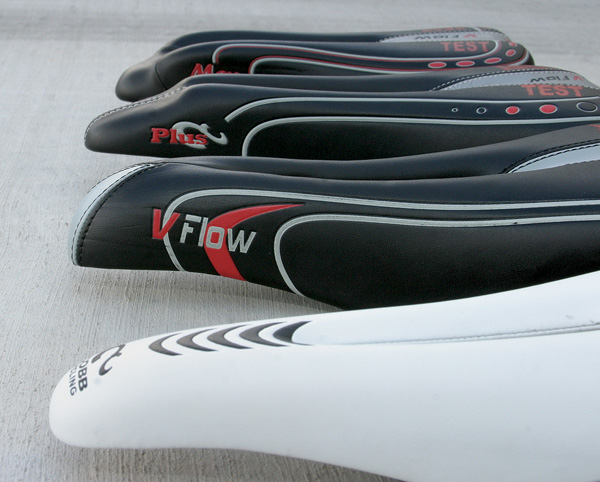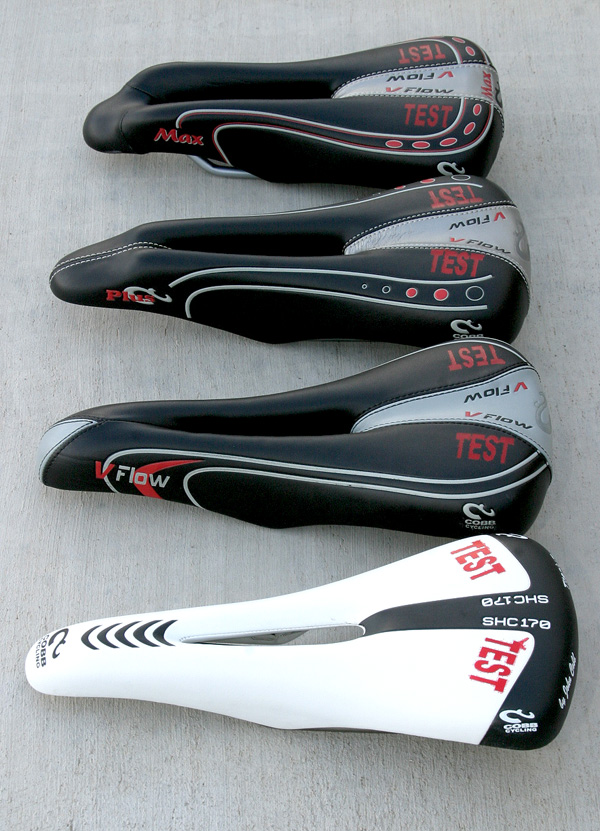
By Tom Demerly for TriSports University.
There are a few true pioneers in our sport: Innovators, thinkers, tinkerers. These are the “DaVincis” of triathlon: Dan Empfield, Steve Hed, Jean Beyl (inventor of the Look clipless pedal). John Cobb is one of them. Cobb is a technology leader not only in triathlon but, before that, road cycling. Cobb is among the first practitioners of systematic bike fit from an aerodynamic and biomechanical perspective. Since 1972 John Cobb has applied principles learned from automotive and motorcycle racing, and developed his own solutions, to improve cycling performance. Those solutions include early wind tunnel testing to reduce drag and biomechanical positioning to optimize power output, efficiency and comfort.
Like most innovators Cobb discovered the optimum solution to cycling problems required a re-thinking of traditional ideas. The saddle is one of those areas. Cobb’s latest project, Cobb Cycling, is a technology brand that has innovated and evolved those solutions.
“With a Cobb Cycling saddle you aren’t just buying a new saddle, you are getting the tools and instructions to optimize your own saddle position.”
Saddle discomfort is an amalgam of bike fit, heat, pressure and friction. These factors combine to create numbness, saddle sores, pain and even injury. The solution to saddle discomfort is also an amalgam of factors, the primary one being bike fit and position. One of the most unique features of Cobb Cycling saddles is that each saddle includes a miniature “Fit Kit” with the saddle. Cobb is the first to acknowledge- with the product– that part of what you are buying with a new saddle is fit. Inside each Cobb Cycling saddle is a mini “Fit Kit” that enables you to replicate your existing saddle position, and then optimize it with your new Cobb Saddle to relieve saddle discomfort. With a Cobb Cycling saddle you aren’t just buying a new saddle, you are getting the tools and instructions to optimize your own position. While this doesn’t make the laymen an expert bike fitter, it does provide a key insight missing from every other saddle product.
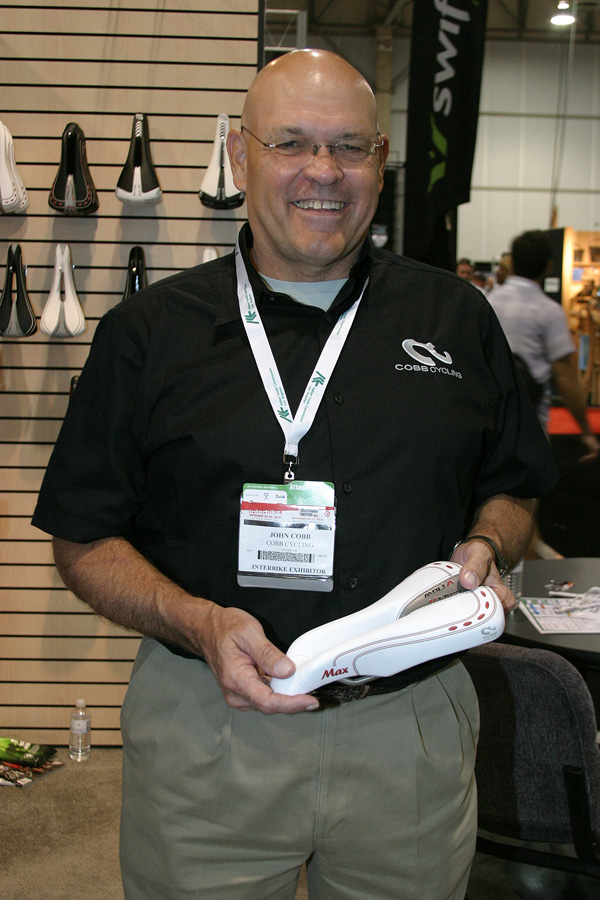
Each Cobb Cycling saddle comes with a metric tape measure, a set of metric Allen wrenches of specific size and length for work on seatposts, an open end wrench and excellent measurement and installation instructions. Additionally, Cobb Cycling has produced a good video on saddle set-up you can see here.
In addition to the fit and position perspective provided with every Cobb Cycling saddle there are many unique technologies in each of the five Cobb Cycling saddle models. The first is the use of firm memory foam to provide support and maintain saddle shape. Many saddles use a “comfort cut out” to provide pressure relief from the center of the saddle. The problem with most saddle cut-outs is they tend to close up when you sit on them. On the shelf the saddle intuitively seems like it will work well, but with a rider is seated on the saddle the comfort cutout is pressed shut by rider weight. Cobb Cycling saddles use a firmer memory foam that resists this deformation, maintaining the original shape of the saddle even (and especially) under rider weight-more on that in a moment…
“One of the most unique features of Cobb Cycling saddles is that each saddle includes a miniature “Fit Kit” with the saddle.”
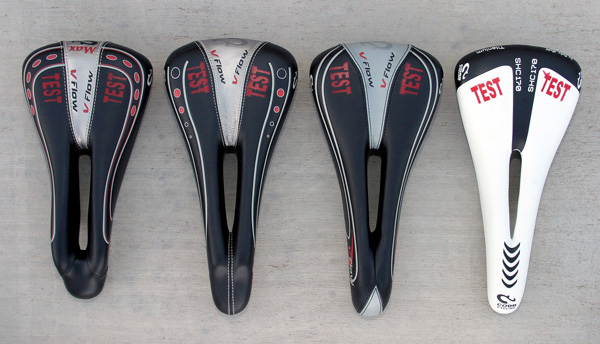
The shape and location of the pressure relief cut out is another key technology in Cobb Cycling saddles. John Cobb used a device called the Form Sensor Array TekScan, a flexible tactile force sensor, to evaluate “hot spots” that contribute to numbness, discomfort and saddle injury. Using this data the shape, size and placement of the pressure relief cut outs in Cobb cycling saddles were optimized. This pressure mapping approach to saddle design combined with the use of specific density memory foam in the saddle itself mean the Cobb Cycling cut-outs truly function under rider weight and over long durations in the saddle.
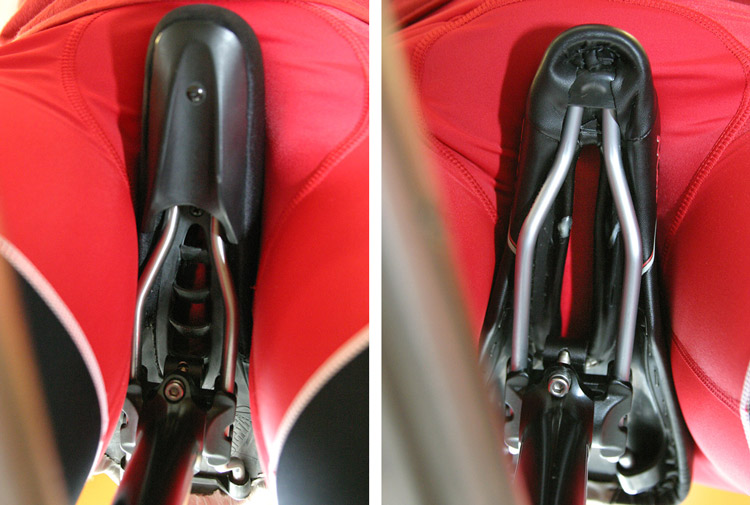
Because heat is one of the factors that contribute to saddle discomfort the rear section of Cobb V-Flow and V-Flow Plus is configured in a “venturi” design to help channel cooling air flow up through the saddle and out the back. The design works noticeably across all speeds. This is similar to the concept behind Profile Design’s Tri Stryke Elite saddle with its set of internal ventilation stiffener vanes in the cutout but the Cobb Cycling design accomplishes an even better result by removing material and reducing weight rather than adding material.
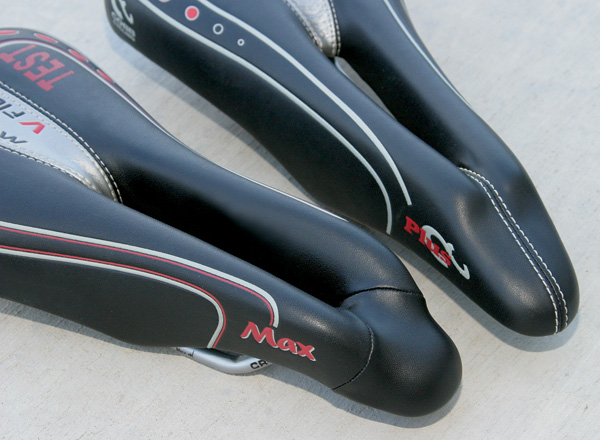
As mentioned, a key technology in the Cobb Cycling saddles is the memory foam that has become so prevalent in many medical and ergonomic applications including high end mattresses. Memory foam helps distribute pressure evenly reducing pressure points and distributing saddle load. This is the same technology used in medical grade mattresses such as Healco and Tempur-Pedic Mattresses to reduce bed sores and improve support. The density of the memory foam in Cobb cycling saddles is optimized for rider load in the saddle area and to maintain the functional shape of the relief cut-out even with a rider seated on the saddle. It isn’t too soft, isn’t too firm. Having ridden some of the Cobb saddles I’ll concur with this.
“Memory foam helps distribute pressure evenly reducing pressure points and distributing saddle load.”
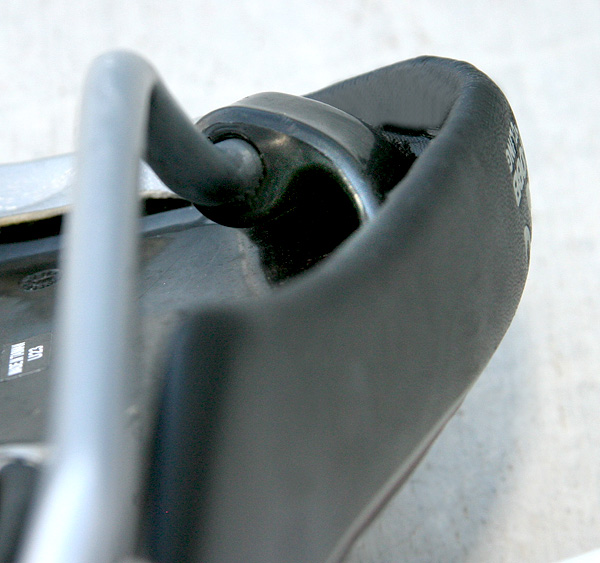
The molded-in seat design of the Cobb Cycling saddles also promotes proper saddle posture, another feature unique to Cobb Cycling and a direct result of John Cobb’s work on positioning riders in the aerodynamic posture. A common mistake for new riders is to orient their pelvis vertically on the saddle. This will result in lower back pain through fatigue of the erector spinae muscles as they try to support the weight of the torso. The unique “rocker” or curve to the profile of the Cobb Cycling saddles facilitate a more “forward rotated” pelvic orientation. This enables you to reach your aerobars easier with less lower back strain and a more comfortable crotch. This is an especially critical feature for rides over two hours and one missing on nearly every other saddle design.
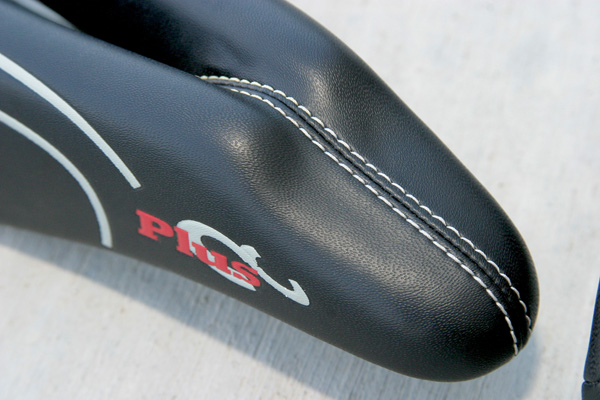
All the saddle technology in the world is lost without nice workmanship and materials and John Cobb brought some true craftsmanship into the construction of Cobb Cycling saddles. The saddle covering is wear resistant even when ridden in wet tri shorts. It is free of stitching in vital friction areas. The stitching that does hold the saddle cover in place is recessed and executed with such craftsmanship and precision it looks like something on the interior of a high end sports car. Saddle rails are durable alloys including titanium on the V-Flow SHC-170. Saddle rails don’t join directly to the saddle frame, but support the saddle frame by way of a leaf-spring type mount at the back of the saddle on each side. This design further reduces vibration and road shock.
A key feature to each of the Cobb Cycling saddles is the thigh-slide vane that protrudes downward on either side of the front 1/3rd of the saddle. This is another adaptation to facilitate the use of lightly padded tri shorts over long distances. Other low profile, lightweight saddles such as the Selle Italia SLR series have nice low profile but the edge of the saddle can chafe your inner thighs. The thigh-slide vanes on the Cobb Cycling saddles prevent abrasion of the inner thigh by providing a friction-reducing surface to glance off of.
The V-Flow Plus and V-Flow Max saddles feature a deeper channel with more foam and a different shape to optimize pressure relief, air flow and further reduce discomfort and numbness while facilitating circulation in the saddle area. Additionally, the nose of these saddles is heavily radiused to reduce pressure on the forward part of saddle anatomy, a feature critical to both genders.
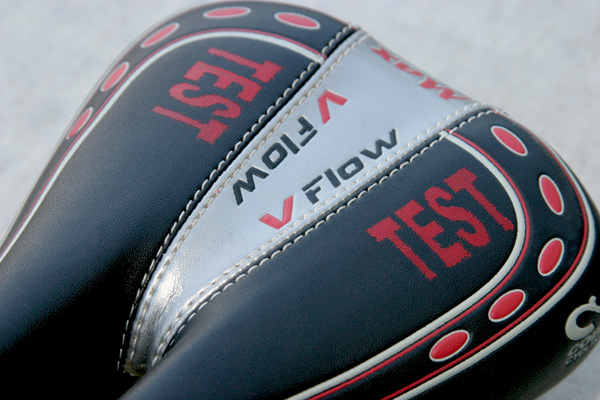
Key Technologies, Features and Benefits to Cobb Cycling Saddles:
Specific Durometer Memory Foam Padding: Distributes saddle load over wider area reducing pressure points and providing support without saddle deformation. Saddle comfort cut-out still functions. Not too soft, not too firm.
V-Flow Ventilation: Prevents build up of heat in the saddle area that contributes to saddle discomfort and saddle sores.
Molded Concave Seat Base Profile: As viewed from the side the saddle has a specific “rocker” or concave profile to optimally position the pelvis for an aero posture without crushing soft tissues and while reducing lower back strain.
Anatomically Crafted Saddle Upholstery: Precision pattern making and craftsman-like stitching provide a smooth, friction reduced surface to reduce chafing and facilitate comfort, even in wet tri shorts. Also facilitates extended durability (along with memory foam).
Relief Design Cut-Out: Unlike other saddles with holes the Relief Cut-Out in Cobb Cycling saddles is designed using a flexible tactile force sensor to identify saddle hot spots in the design process. As a result the shape, size and placement of the relief cut-out are optimized. Specific Durometer Memory Foam insures the relief cut out will maintain its shape even under rider weight.
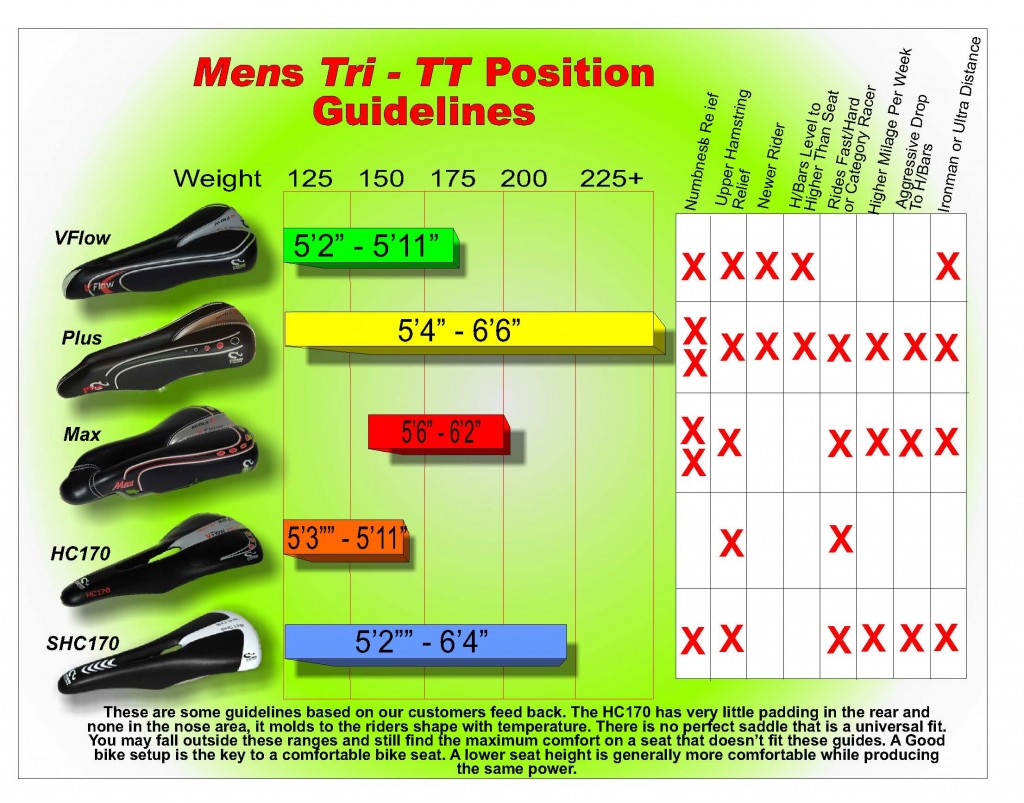
Finally, a key feature unique to Cobb Cycling saddles is that the saddles are full length- ranging in length from 26 centimeters to 27.5 centimeters. This is critical for maintaining both saddle comfort and overall performance since it enables the rider to move forward and backward on the saddle for changes in the pedal geometry- and comfort. Some “nose-less” saddle designs provide good comfort and pressure re-distribution but limit the range of postures the cyclist can maintain on the saddle. This limits the function of the saddle and concentrates pressure in one area. Cobb Cycling saddles enable the rider to achieve comfort over the entire length of the saddle, not just one spot. This means you can change pedaling styles while climbing or during hard efforts in the aero posture.
The Saddles.

Cobb Cycling V-Flow Max.
The V-Flow Max is the ideal long distance saddle. The memory foam is the Cobb Cycling V-Flow Max is new, higher density foam that maintains support of your pelvis and protection of your soft tissues for longer duration. The perfect Ironman saddle. This is the latest Cobb Cycling saddle that includes everything learned from previous versions. If you are going long this is the saddle we’d recommend. This saddle uses a 58 mm wide nose with unique concave sides to reduce friction and help maintain the saddle cut-out over long distances. The back of the saddle is 130 mm and the overall length is 26.3 centimeters. 277 grams on our scale and $169.99.

Cobb Cycling V-Flow Plus.
Another perfect saddle for long hours on the bike and in the aero position. This version of the original V-Flow is actually an improved and updated version (hence the “Plus”)of the first Cobb Cycling saddle. The new V-Flow Plus has a more tapered nose than the V-Flow Max measuring 47 mm at the front of the 120 mm wide tail section. This may suit smaller riders well. Another great saddle from Sprint distance up to Ironman. The saddle is a long-ish 27.5 cm providing ample opportunity for finding the optimum posture for climbing and descending while keeping the saddle area fresh and preventing numbness. This saddle weighs 278 grams and is $149.99.

Cobb Cycling V-Flow.
If you favor a more conventionally configured saddle the V-Flow bridges the gap between tradition and innovation. This saddle incorporates the basic saddle performance principles developed by John Cobb for Cobb Cycling including the relief cut-out, optimal density memory foam and V-Flow ventilation channel along with the thigh-slide vanes and the unique profile for best positioning of the rider’s pelvis. If you are a road cyclist transitioning to a triathlon geometry bike this is your first stop. Compared to other saddles in this category the $129.99 price tag is an exceptional value. 278 grams with a 27.2cm overall length and a moderate 44 mm nose in front of a 30 mm wide tail.

Cobb Cycling V-Flow SHC-170.
A super high performance saddle with luxury comfort. The moldable base uses the thinnest memory foam to reduce weight and improve support during ultra-high watt efforts. The narrow 38 mm nose facilitates powerful pedaling and suits smaller, lighter riders ideally. The rear of the saddle is the traditional 130 mm. At only 210 grams this saddle uses titanium rails and features full thigh glides and the unique Cobb Cycling rocker to support optimum orientation of the pelvis and vertebrae in the riding position.
Technology, Adaptation and Education.
Cobb Cycling saddles feature innovative and adaptive designs born in the real world for the way athletes really ride. They are designed not just for professionals with excellent saddle acclimation and a deep training base, but also for the average athlete trying to pile on the miles in preparation for a long triathlon. Unlike any other saddle brand, Cobb Cycling saddles acknowledge and facilitate the need for proper saddle positioning and set up right out of the box, including the tools and instructions to empower you, the athlete and customer, to do your own set-up. While this is not a substitute for a complete bike fitting, it does facilitate good saddle set-up and fosters an understanding of the fit factors involved in saddle comfort.
I’d rate John Cobb’s Cobb Cycling saddles as the best range of saddles available to the multisport cyclist across a broad spectrum of experience levels and especially for the newer athlete.
